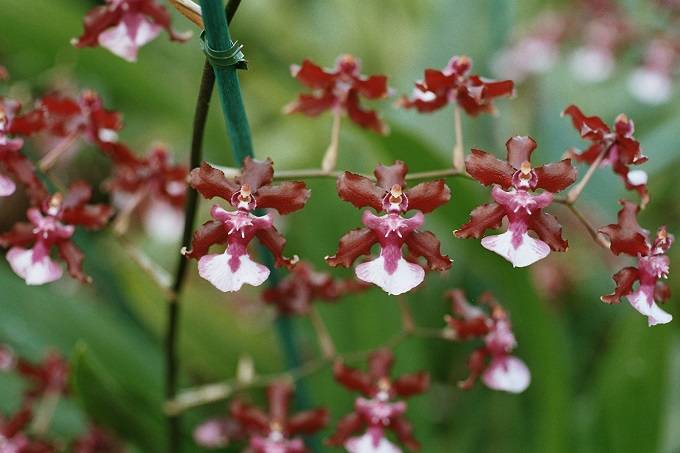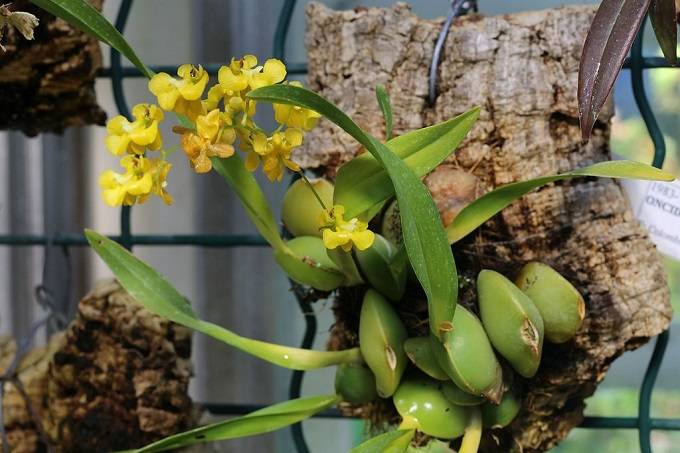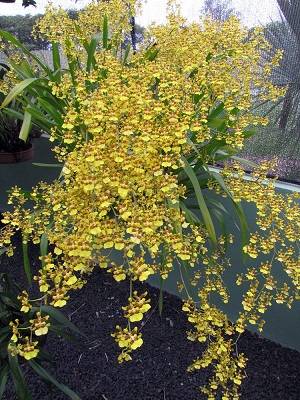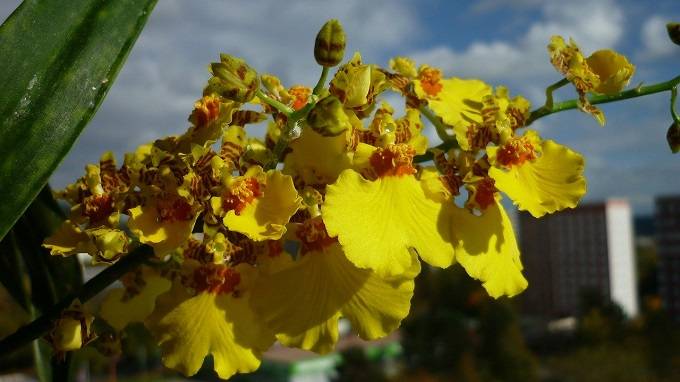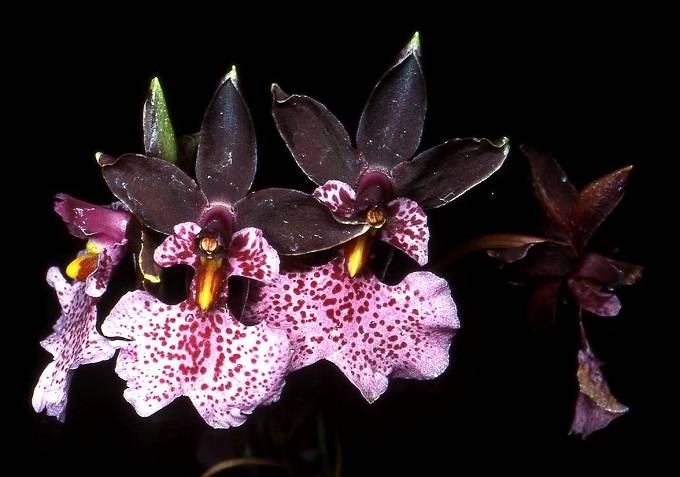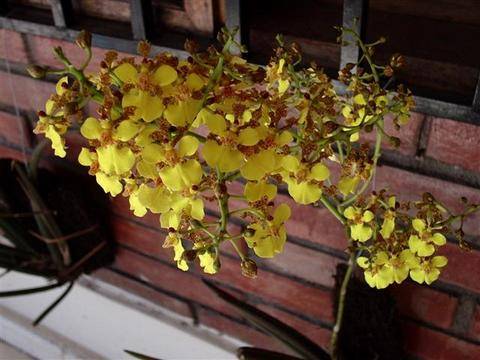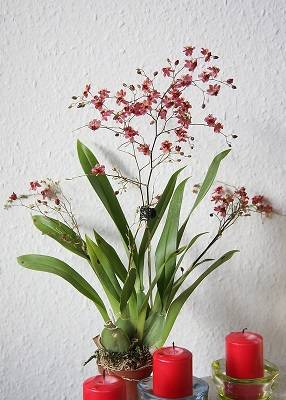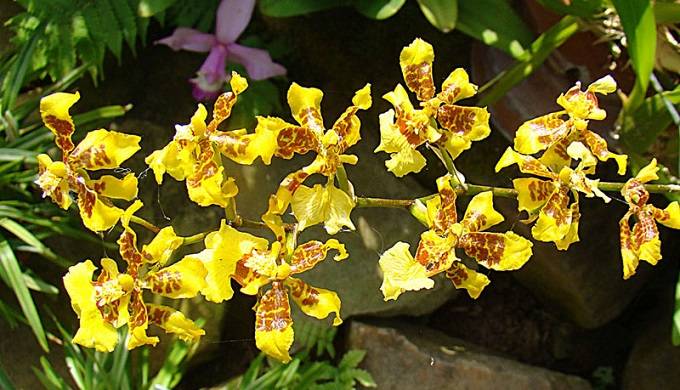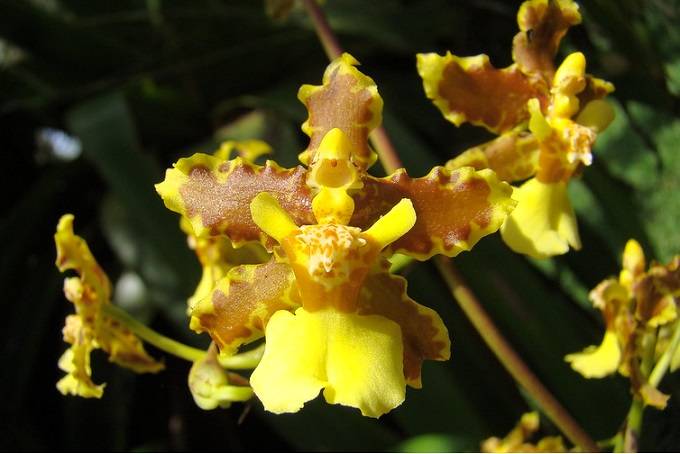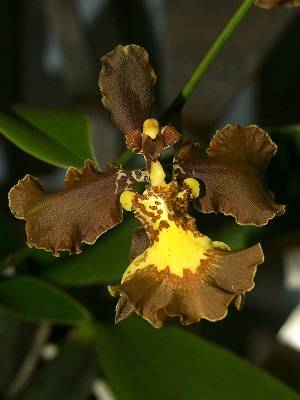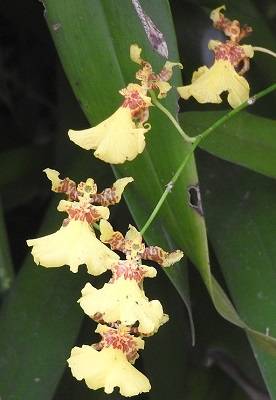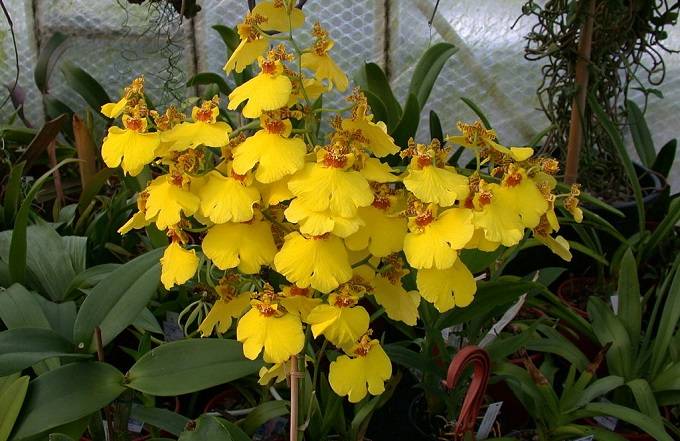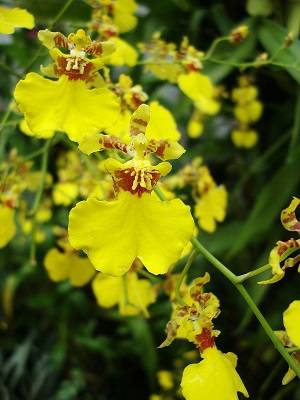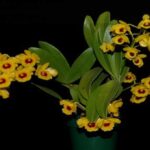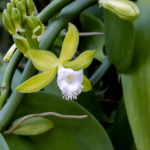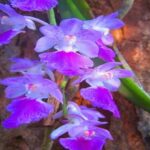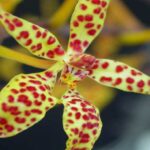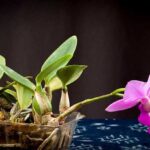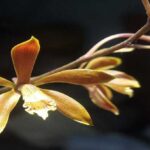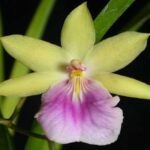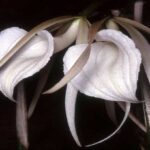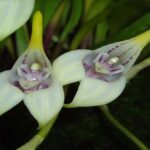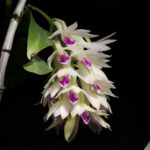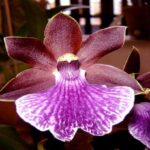Do you know the Oncidium orchid? (Known popularly as Dancing-lady Orchid, this is one of the most admired orchids among cultivators from various parts of the world.)
And all this admiration is for several reasons:
- Easy cultivation
- Beauty of the flowers
- Ease to find them in almost any orchid nursery
Therefore, if you own or are thinking about buying an Oncidium, keep reading this article to learn everything about them.
How to Care for Oncidium
Cultivating the Dancing-lady Orchid orchid is considered simple.
Therefore, if you are still a beginner with orchids, don’t worry, this is a very resistant orchid.
Below you will learn the determining factors for the health of your Oncidium:
1 – Where to Plant
Although not one of the main focuses of growers, planting is one of the most important parts when it comes to caring for orchids.
Basically, if you plant your orchid in the wrong place, it will probably die.
So pay attention below.
Most Oncidium orchids are epiphytes, which means they naturally live hanging on trees.
This means you cannot plant your Oncidium in soil. The most suitable places to plant the Dancing-lady Orchid are:
- Pots (especially terracotta pots)
- Trees
- Trunks or bark
To learn how to plant them in pots, watch the video below:
Dancing-lady Orchid on Trunk
Now, if you want to attach it to trees or trunks, follow the steps below:
- Choose the ideal location (trees and trunks must be free of pests and preferably have rough surfaces, as this helps orchids attach)
- Place your orchid delicately and to help it fix itself, tie it with a string, but not too tight.
- Ensure the location provides what your orchid needs (your orchid must be protected from direct sunlight, but it cannot be without light)
To facilitate your understanding, watch the video below on how to attach orchids to trees.
2 – Potting Mixes
Potting mixes are essential parts of cultivating this orchid in pots.
Basically, they help fix your orchid in the pot and also help you identify when it is time to water your plant.
The ideal substrate for your Oncidium is made with:
- 40% sphagnum moss
- 30% charcoal
- 30% ground pine bark.
But this is not a rule; you can use other substrates like gravel, macadamia bark, coconut fiber, etc.
3 – Watering
Finally, we come to one of the most feared factors among growers, watering your orchid. Basically, one of the main reasons for diseases and losses of orchids among beginners is improper watering.
Therefore, providing this factor well is so important. Pay attention; watering can vary depending on various factors:
- Where your orchid is
- The climate of your city
- Substrates you use
- The phase the plant is in (growth, dormancy, or flowering)
- Among several other factors
Therefore, I cannot define a specific interval of time to water your orchids; only you can do that over time. But, there is an alternative.
I can teach you how to identify when your orchid needs water.
When to Water Your Orchids
There are some tricks you can use to identify if it is the right time to water your orchids.
First, hanging Oncidium:
- Know that they are epiphytic orchids
- All epiphytic orchids have a structure called velamen on their roots
- When this structure dries out, it starts to turn gray.
In other words, whenever the roots of your orchid start to turn white or gray, it’s time to water. Usually in hanging orchids, watering is more frequent, on average once a day or once every 2 days.
Now, let’s learn to identify when to water potted Oncidium:
- You need to look at your plant’s substrates
- Put your finger in the middle of the substrate and check its moisture
- If it’s dry, water your Dancing-lady Orchid; if it’s still moist, check again the next day.
Below are some useful tips for watering:
- Remember, orchids don’t like moisture in their roots, so never leave a tray of water under your pots.
- Water your Dancing-lady Orchid in the late afternoon, as they like to be moist at night.
- Orchids with thicker leaves and roots are usually watered less frequently because they have a high water retention capacity.
4 – Lighting
The Dancing-lady Orchid is very famous for its great resistance to temperature. And this also applies to lighting. They can receive much more light than other species like Phalaenopsis or Vanda.
Basically:
- The ideal is partial shade, that is, 50% brightness
- There are also species that like to be in direct sunlight for 1 to 3 hours, during the times when the sun is weaker.
The same rule applied to watering can also be used in this case. Oncidiums with thicker leaves usually prefer more light.
Another tip is to observe their leaves. Basically, if:
- Your leaves are more yellowish, they are receiving too much sun
- Your leaves are dark green, they need more sun
See the article spots on orchid leaves to learn more signs that orchids show us during cultivation.
5 – Temperature
Temperature is another factor where Oncidium stands out. It is ideal that you provide moderate to slightly warm temperatures, but never in excess.
But, despite not liking it, the Dancing-lady Orchid can also adapt to lower temperatures.
The ideal for this orchid is:
- 12°C to 16°C (53.5°F to 61°F) at night
- 26°C to 30°C (79°F to 86°F) during the day
But they can also withstand temperatures up to 38°C (100.4 °F) if humidity and ventilation are high (source – aos)
6 – Humidity
It is important to remember that when I talk about air humidity, I am not referring to watering your orchid.
Basically, humidity serves to keep your orchid healthy and free of pests or diseases.
- If the humidity is low, your orchid will become weak.
- If the humidity is too high, your orchid can be attacked by diseases, such as Black Rot.
Oncidium orchids need less humidity than most other genera. So, know that the ideal is for humidity to vary between 30% to 60%. To check humidity:
- You can use a weather forecasting website
- You can buy a humidity checker for your home or orchid house (recommended for those who grow many orchids)
7 – Fertilization
Finally, we come to one of the topics that leaves cultivators most in doubt, fertilization. Basically, there are 2 main types of fertilizers:
Organic Fertilizers
These are fertilizers obtained from vegetable or animal origin, such as manure, flours, bagasse, peels, and vegetable remains, decomposed or still in the process of decomposition.
This is a natural fertilization in which the plant slowly absorbs nutrients. Some of the most famous organic fertilizers are:
- Bokashi
- Osmocote
- Bone meal
Chemical Fertilizers
Chemical Fertilization is the name given by the International Organization for Standardization to the fertilizer in which the declared nutrients are in the form of inorganic salts obtained by extraction and/or by chemical and/or physical industrial processes.
Usually, this is the most recommended fertilization because it is much simpler.
Basically, chemical fertilization has some advantages:
- It is faster and simpler
- It does not release bad odors
- It is possible to have greater control over the nutrients your orchid receives through it
So, if you are a beginner, I advise you to fertilize your Dancing-lady Orchid with chemical fertilizers, especially if the cultivation is indoors.
Below are some formulations you can use:
- NPK 10 10 10 (in any period except flowering)
- NPK 30 10 10 (when your orchid is grown in bark)
- NPK 20 20 20 (when your orchid is not grown in bark)
Apply 1 to 2 times a month.
8 – Repotting
Repotting is a process that can often be complicated and cause headaches.
Remember that to avoid problems, you need to repot your orchid during its growing period, i.e., when new shoots and leaves are appearing.
Watch the video below explaining how to repot orchids:
9 – Other Cares
Finally, below are some tips that can be useful for your cultivation:
- Ensure that the place where your Dancing-lady Orchid is grown has good air circulation; this will prevent attacks from fungi and pests.
- The multiplication of this orchid is done through the process of dividing the plant.
- When the flowering of the Oncidium is over, cut the flower stems, as they will not produce new blooms.
- If your Oncidium is attacked by mealybugs, see this article.
Dancing-lady Orchid Blooming
Now that you have learned how to cultivate the Oncidium, how about knowing a little more about this orchid’s main characteristic?
Its flowers are very small and numerous.
Some species have fragrant flowers, for example, the Oncidium Sharry Baby known as the chocolate orchid, because it exudes an aroma similar to chocolate.
The duration of its flowers can vary greatly depending on its cultivation and also its species, ranging from 7 to 40 days.
Many people think that the Dancing-lady Orchid only has yellow colors, but in fact, there are species that can produce flowers of various other colors, such as pink, white, orange, brown, etc.
They can bloom up to 2 times a year. The Oncidium Retemeyerianum has flowers all year round because its flowers open throughout the year.
Main Species
Among all Oncidium species, there are some that stand out among cultivators.
This fame can be for various reasons, such as the flowers, the aroma, or simply because the species is easily found for sale.
Below are some of the main species of the genus Oncidium:
- Oncidium crispum
- Oncidium altissimum
- Oncidium aloha Iwanaga
- Oncidium twinkle
- Oncidium sharry baby
Now let’s talk a little more about each of these species:
Oncidium crispum
There is a discussion about the true classification of this orchid; while some consider it Oncidium, others consider it Brasilidium.
But Brasilidium is a controversial genus, and here’s the reason:
In 2006, RHS transferred numerous Brazilian plants from the genus Oncidium to the genus Gomesa, not considering their morphological aspects. A serious mistake.
Unhappy, renowned Brazilian orchidologists such as Vitorino Paiva Castro Neto, Marcos Antonio Campacci, and Erwin Bohnke decided to create a different nomenclature for these plants, and this is the line I follow and will follow.
Described in 1832 by John Lindley, this is a Brazilian orchid.
We can find it in the Atlantic Forest, especially in the south and southeast of Brazil. It lives on trees and is found at altitudes between 600 to 1500 meters (1968.5 to 4921 feet) above sea level.
Oncidium altissimum
Oncidium altissimum is an epiphytic orchid found on the Lesser Antilles islands of Martinique, Trinidad, and São Vicente.
Its flowers are on average 1 inch in size, and its cultivation is considered simple, especially if it receives plenty of sunlight and is watered regularly.
Some curiosities about this species include:
- According to Wikipedia, during flowering, this Oncidium can produce up to 300 flowers.
- It is commonly found in places where there are several ants.
Oncidium aloha iwanaga
Oncidium aloha iwanaga is a hybrid orchid created by E. Iwanaga and registered in 1990 by M. Sato.
Basically, to obtain this orchid, numerous crossings are necessary.
During its flowering, it produces dozens of flowers that can reach up to 4cm (1.5 inches) and are scentless.
To learn more about them, visit the article in Portuguese by the great orchidophile Pablo Heller: https://orquideasjph.wordpress.com/2017/10/04/oncidium-aloha-iwanaga/
Oncidium twinkle
This is a dancing-lady orchid that can bloom in any season, but we usually see its flowers during the cold weather.
This can be considered a mini orchid because its flowers do not exceed 0.4 inches, and the plant generally measures between 10 to 15cm (4 to 6 inches) in height.
Like the previous species, Oncidium twinkle is also a hybrid of the following species:
- Oncidium cheirophorum
- Oncidium ornithorhynchum
Both found in Central America on top of trees (epiphytes).
Oncidium sharry baby
Also known as the chocolate orchid, Oncidium sharry baby is also a hybrid.
Created in 1983, this species became very famous due to the fragrance of its flowers, which is very similar to that of chocolate.
Regarding its flowering, it can occur at any time of the year, lasting between 30 to 45 days.
Its flowers are very small and numerous.
Curiosities About Oncidium Orchids
Oncidium is the scientific name for orchids popularly known as dancing-lady orchid or golden shower orchids in some countries.
Created in 1800 by O. Swartz, the name Oncidium comes from the Greek onkos, which means volume; this name occurred due to the callus that these orchids have at the base of their lip.
An important piece of information to remember when cultivating these orchids is that they can have small spots on their leaves.
Despite appearing to be a problem, these spots are natural and will not harm your plant.
The Silver Rain Orchid
During my research about these orchids, I came across something very curious, and I believe that few orchid enthusiasts also know about this.
Did you know that there is also the silver rain orchid?
This is the popular name for Ionopsis paniculata.
They were named this because of the colors of their flowers, which are almost entirely white.
An Interesting History
Currently, only 330 natural species of orchids are considered Oncidium.
But it wasn’t always like this.
In the early classifications, when there were not so many means to identify orchids, the Oncidium genus had the same problem as Epidendrum.
It became a place where botanists placed genera they were not sure how to classify.
This way, over time, this genus grew and decreased in size, reaching 1378 species at a certain point in history.
Where They Are Found
Below are the places where orchids of this genus can be found:
North America:
- United States
- Mexico
Central America:
- Honduras
- Panama
- Nicaragua
- Guatemala
- Costa Rica
- El Salvador
- Cuba
- Among others
South America
- Brazil
- Argentina
- Colombia
- Ecuador
- Peru
- Guiana
- Among others
Conclusion
This was our complete guide on Dancing-lady Orchid; I hope you liked it.
Our goal is that through this article, you can better cultivate your Oncidium and also learn more about this species.
Liked this article? Then help us by sharing it on your social networks.
We will be very happy if you do.
Do you have any questions, suggestions, or would you like to share your story? Then leave your comment below.

